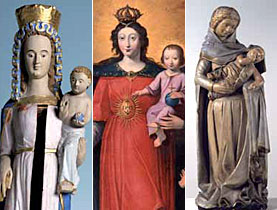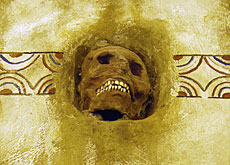Exhibition uncovers female side of God

The first book of the Bible tells us God created humankind "male and female" in his own image. Yet Christianity has consistently projected an all-male image of God.
A new exhibition showing in Fribourg aims to set the record straight, by lifting the veil on the feminine face of God.
More than 300 exhibits span a period of 10,000 years. The female objects of worship include the Egyptian goddess Isis and the Virgin Mary.
Othmar Keel, who co-organised the exhibition, says changes in society have brought pressure for a new look at the portrayal of the Old Testament God.
“For a long time it was only men who decided about the image of God, and how God has to be presented,” the professor of Old Testament studies told swissinfo. “The only male God is somehow the last resort of patriarchy.”
The exhibition shows how the female images and themes of the polytheistic cultures are later reflected in the great monotheistic religions of Judaism and Christianity. It does so by juxtaposing and contrasting ancient artefacts and pictures from more modern times.
Hair and breasts
The first section looks at the subject of hair, a current theme given the debate over the role of the veil in Islam. A series of ancient terracottas from the Middle East depict goddesses with exaggerated female characteristics and abundant hair – a sign of vitality and sexuality. Facing them the habit-clad figure of a nun speaks volumes about Christianity’s tendency since St Paul to see a woman’s crowning glory as a source of temptation.
The root of the idea could go back as far as Eve: a plaque from the 5th to 6th centuries shows the first woman with wild, flowing hair – an image of debauchery.
The portrayal of female breasts is another aspect well documented by the exhibition. The goddess Asherah – worshipped in Jerusalem and even seen as God’s partner until the Jewish religious reform of 622 BC – is portrayed proudly displaying her pert bosom. On the one hand a source of erotic pleasure, the breasts were also seen as a necessity for transmitting life.
The image of the breast is one also taken up in depictions of the Virgin Mary. Facing Asherah is a picture dealing with the curious legend of the Virgin and St Bernard, where the mother of Jesus is seen expressing milk from a breast to wet the lips of the saint who has asked her to become her son.
Mary and Isis
The Virgin Mary is a central figure in the exhibition, venerated as the mother of Jesus, but for Catholics placed just lower than God.
“We realised that all the kinds of roles these goddesses took – as mother, virgin, fighter, as dominating plants and animals, you find again in the picture of the Virgin Mary,” commented Keel.
But the image of the Virgin changes down the centuries: from the mother of Jesus, she becomes the centre of attention herself, holding her son away from her body.
“If you look at these pictures, she is distributing grace by her own authority,” said Keel. “Of course, every Catholic knows she is not a goddess, but if you look at her pictures she acts like a goddess.”
The Fribourg University professor explains that like ancient goddesses the Virgin responds to a basic human need, at the same time as fulfilling an ideal.
The ideals attributed to the Virgin were in earlier times associated with the cult of Isis, widespread in the Mediterranean region from the 1st to 3rd centuries AD.
Isis represents the ideal woman fulfilling the typical roles of caring for husband and children. After her husband is murdered her attentions bring him back to life, and she is able to conceive and bear his child, before he leaves to become the king of the underworld. Isis is left to bring up her child, becoming the perfect mother.
Trees and animals
One section is given over to depicting the relationship between woman and the natural world. According to Keel, many goddesses were represented as trees. And in the Bible, it is written that God himself did not create the plants and animals but instructed Mother Earth to do so.
Christianity later made a connection between the Virgin and trees and plants.
“In Switzerland there are at least a dozen places where it’s said the Virgin Mary appeared in a tree,” said Keel. “The tree has something of protecting, shadowing, taking care and feeding.”
The association of mainly erotic goddesses with animals, particularly the lion, was a common one over thousands of years. Images from the exhibition show a naked goddess standing on a lion’s back, a clear combination of sex and power.
Keel points out that the ancient association of sexuality and holiness was not taken up by Christianity. But two thousand years later, sexuality is once again a form of idolatry in our modern society.
“In the polytheistic world eroticism and sexuality was almost something holy, as in the modern world,” said Keel.
swissinfo, Morven McLean in Fribourg
The exhibition L’eternel féminin/Gott Weiblich, From the Middle Eastern Goddess to the Image of Mary runs at the Musée d’art et d’histoire Fribourg until April 6, 2008.
The Virgin Mary exhibits come from the Musée d’art et d’histoire and from monasteries in Fribourg.
Most of the idols and goddess figures on display come from the Fribourg University Bible + Orient Collection and originate in Palestine, which was at the centre of the ancient cultures of Egypt and Mesopotamia and also came under Greek influence.
Other works are on loan from the Israel Museum and other museums.
The 14 themes of the exhibition:
– Hair: displayed and covered
– The blessing of breasts
– Intercessor
– Queen of heaven
– Maat and Sophia: wisdom goddesses
– Inaccessible mystery
– Life and death: motherhood and lamentation
– Isis and her family drama
– Goddess and plants
– Goddess and animals
– Goddess and the lion
– Tanit: a dangerous mother?
– The virgin warrior goddess
– Goddesses and the dove as a messenger of love

In compliance with the JTI standards
More: SWI swissinfo.ch certified by the Journalism Trust Initiative










You can find an overview of ongoing debates with our journalists here . Please join us!
If you want to start a conversation about a topic raised in this article or want to report factual errors, email us at english@swissinfo.ch.